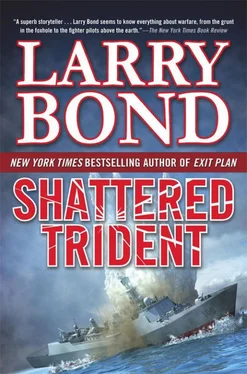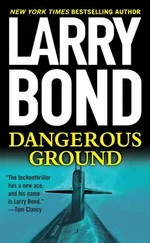The expression on Jerry’s face must have changed, as Sobecki started chuckling. “There, are you happy now, Skipper?” he teased.
His head hanging low, Jerry let out a long sigh. “Well, at least it now makes sense. But…”
“But,” interrupted Sobecki, “the Kilo is now heading straight for the Song.”
“Yup, that about sums it up.”
“Do you want me to summon the XO to control?”
“Yes, please, Engineer.”
As Sobecki called for Thigpen over the 1MC, Jerry moved closer to the large display on the port side—his thoughts focusing on the tactical picture. The situation was degrading slowly. It would be at least half an hour before the Kilo would reach a firing position, assuming the Song didn’t change course. But what could he do with that time? Would it even be possible to break up the attack? His orders were pretty straightforward, and everything that came to mind violated those orders.
It didn’t take Thigpen even a minute to reach control, and by then the fire control system had determined, conclusively, that the Kilo was on a perfect intercept course. There was no mistaking what was happening. The Vietnamese Kilo captain was getting into position to ambush the Chinese submarine. Jerry’s mind was racing. Shooting tankers was bad enough, but attacks against another country’s naval vessels kicked things up a notch. And then there were the safety concerns for his own boat. They weren’t far enough away to be immune from a stray torpedo. Should he just bug out and put more distance between the warring parties? He really didn’t like that option, but there seemed to be nothing else he could do. If only they could come up with a way to spook the other subs without giving themselves away.
“Skipper, I understand your desire to prevent bloodshed, but what can we do without revealing our presence?” pleaded Thigpen.
“That’s what I’m trying to figure out, Bernie!” snapped Jerry. He stopped and took several deep breaths. His XO wasn’t the enemy and Thigpen was only doing his job—perhaps, annoyingly, a little too well at the moment. His mind refocused, Jerry reapproached the problem.
“Okay. Active sonar is out. It’s a big neon sign that says ‘shoot here.’ The UUV is too far away, so we can’t use it as a diversion. And the mobile decoys are tuned for acoustic homing torpedoes.” Jerry ticked off the options on his fingers one at a time.
“And we can’t use any of our ADCs, as their electronic noise would be easily ID’d as American,” added Thigpen.
It was Thigpen’s last words that suddenly gave Jerry an idea. One that just might work. “Weps, we still have a few of those old NAE Mark 3 beacons on board, don’t we?”
“Yes, sir. We use them during exercises. They’re a lot cheaper than an ADC Mark 4.”
“Captain… what are you thinking?” Thigpen asked suspiciously.
“It’s quite simple, XO.” Jerry looked around for a piece of paper to draw on. Then remembered that there weren’t any paper plots—there wasn’t any room for them with all the electronic displays in a Virginia -class sub’s control room. Grabbing a pen from his pocket, he pointed to the geoplot display on the command workstation.
“We pull in behind the Kilo, overtake him, and drop an NAE with a time delay between the two boats. We then pull off to the north before either party has a chance to figure out what the hell happened.”
“But, sir, we’ll give ourselves away if we drop a countermeasure. They’ll detect it and know we’re here. There is no way to avoid that!” insisted Thigpen.
“You’re right, they’ll detect the NAE—but they won’t know it’s us. They won’t suspect it’s from an American sub!” Jerry exclaimed.
Thigpen was confused, frustrated, and it showed. “Huh? Come again? I’m not following you, Skipper.”
“Okay, look. The NAE is a very old countermeasure; the first models were designed in World War Two, over seventy years ago. It generates noise mechanically, not electronically. Neither the Vietnamese nor the Chinese would suspect the U.S. still has, or would even use, such a low-tech device.
“Also, when I was reviewing the log entries from Michigan ’s engagement with the Iranian Kilo, my skipper, Kyle Guthrie, noted that the countermeasures deployed by the Iranian boat sounded almost exactly like an NAE. Don’t you get it? Both sides have Russian gear, including acoustic countermeasures! Each captain will think the other guy detected him and shot out a decoy! They’ll both be spooked and start evasive maneuvers, while we slink off to the north.”
Thigpen still wasn’t convinced. “But they’ll both be able to hear us when we pull in front. We’d be, what? Maybe two or three thousand yards away for either sub. We’re really quiet, but that’s way too close.”
“Correct again, we’d be too close. Both the Kilo and Song captains are boresighted toward the surface. The Song, so he doesn’t get run over by a passing merchant, and the Kilo as he’s setting up his attack. Neither sonar system can look at more than one depression/elevation angle at the same time. So we come in right off the bottom, below their sonar’s field of view. The water is shallow here, which will help hide our signature, and we have a negative sound velocity profile down to the bottom—everything is in our favor. Trust me, this will work!”
Jerry watched as Thigpen worked the problem through. He was still unsure, but his CO’s confidence overwhelmed him. Swallowing hard, Thigpen finally said, “It’s your call, sir.”
With a beaming smile, Jerry slapped his XO on the arm. Turning to Covey, Jerry ordered, “Weps, load an NAE in one of the signal ejectors. Set a two-minute time delay.”
“Aye, aye, sir,” replied Covey.
Looking back at Thigpen, Jerry nodded and said, “XO, man battle stations.”
* * *
Once the crew was at general quarters, Jerry explained his plan to the control room watchstanders. He took extra care to make sure everyone understood what they were about to do, and why. The junior officers were awestruck and excited; the more senior ones were apprehensive. Even though the odds were very much in their favor, this was not a risk-free evolution.
As soon as the Kilo was on their starboard beam, Jerry made a sharp turn to the northeast and moved North Dakota into the Vietnamese boat’s baffles. Blocked by the submarine’s hull, the large cylindrical array in the Kilo’s bow couldn’t hear them and Jerry accelerated to fifteen knots.
It was a long, slow overtaking geometry, but twenty minutes later, the Kilo was five hundred yards to port and a hundred feet above them. With only fifty feet between the hull and the sea floor, Jerry slowed to ten knots as North Dakota slowly pulled in front. For the next six minutes, hardly a sound was made in control; even the watchstanders’ breathing was hushed. When they reached the designated point, Jerry ordered the NAE launched, turned north, and slowly increased speed to twelve knots. Thigpen started a stopwatch on the command workstation and called out the time in fifteen-second intervals.
“Fifteen seconds… ten, nine, eight…” Thigpen’s voice was just above a whisper.
“Pilot, ahead standard,” Jerry commanded.
“Ahead standard, Pilot, aye, Captain. Maneuvering answers ahead standard.”
“Very well, Pilot.”
Seconds later the NAE fired up and began rotating the rings of ball bearings inside at high speed. The noise it made was deafening.
Both the Kilo and Song were taken by complete surprise. The Kilo popped a countermeasure of its own, and accelerated to the southwest. The Song stopped snorkeling and headed north at flank speed. Not a single torpedo had been launched.
Читать дальше

![Никки Сикс - Героиновые дневники. Год из жизни павшей рок-звезды[The Heroin Diaries - A Year in the Life of a Shattered Rock Star]](/books/78612/nikki-siks-geroinovye-dnevniki-god-iz-zhizni-pavshej-rok-zvezdy-the-heroin-diaries-a-yea-thumb.webp)










